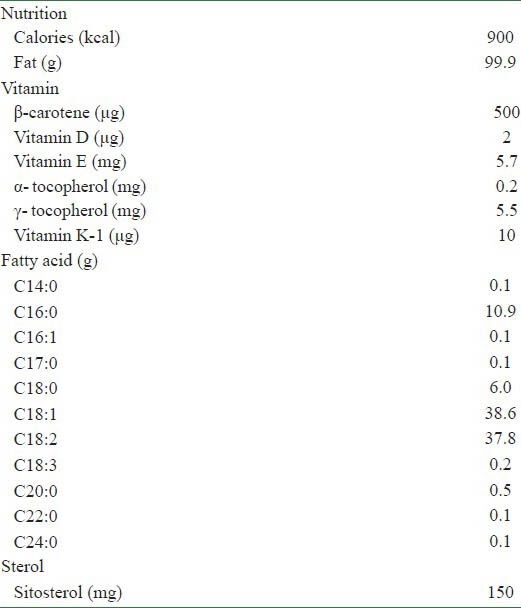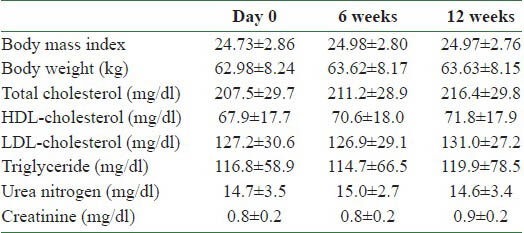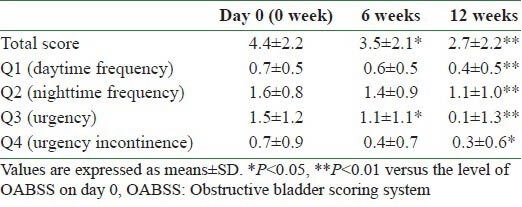Abstract
The pumpkin seed oil obtained from Cucurbita pepo has been shown to be useful for the treatment of nocturia in patients with urinal disorders in several western countries. In this study, we evaluated the effect of the pumpkin seed oil from Cucurbita maxima on urinary dysfunction in human overactive bladder (OAB). Forty-five subjects were enrolled in this study. An extract of pumpkin seed oil from C. maxima (10 g of oil/day) was orally administrated for 12 weeks. After 6 and 12 weeks, urinary function was evaluated using Overactive Bladder Symptom Score (OABSS). Pumpkin seed oil from C. maxima significantly reduced the degree of OABSS in the subjects. The results from our study suggest that pumpkin seed oil extracts from C. maxima as well as from C. pepo are effective for urinary disorders such as OAB in humans.
Keywords: Cucurbita maxima, Overactive bladder, Pumpkin seed oil
INTRODUCTION
The prevalence of urinary disorders such as nocturia and associated symptoms gradually increases with age, and has a great influence on the quality of life.[1,2] Elderly people with nocturia are at great risk for bone fracture and mortality.[3] Thus, prevention and treatment of urinary disorders are expected to improve this problem. Overactive bladder (OAB), a common urinary disorder, is well known and defined by the International Continence Society (ICS) as a syndrome with urgency, with or without urge incontinence, usually with frequency and nocturia.[1] OAB symptoms are commonly observed in patients with dysfunction of the lower urinary tract. Recently, the Overactive Bladder Symptom Score (OABSS) was developed and validated by Homma et al. as a useful assessment tool specifically for evaluating OAB symptoms.[4] OABSS scores are based on answers to self-assessed questions.
Pumpkin is an edible fruit found in the American and European continents and is grown in Asia and Africa. The extract of the seed is a rich source of vitamins, linoleic acid, oleic acid, and microelements. Especially, the oil extracted from Cucurbita pepo has been useful for the treatment of urinary disorders. In previous reports, the effect of the pumpkin seed oil from C. pepo has been investigated in clinical trials involving over 2000 men suffering from benign prostate hypertrophy (BPH).[5] The oil significantly improved their urinary dysfunction. In an animal study, Gossell-Williams et al. demonstrated that oil from the pumpkin seed of C. pepo inhibited testosterone-induced hyperplasia of the prostate of rats.[6] Rats treated with 0.3 mg/100 g body weight of testosterone showed an increase of prostate size ratio, but administration of 2.0 or 4.0 mg/100 g body weight of pumpkin seed oil from C. pepo inhibited the prostate size ratio in rats treated with testosterone. These previous studies have clarified the effect of pumpkin seed oil extracted from C. pepo, but there has been no clinical investigation on urinary disorder treatment using any other kind of pumpkin seed oil.
In Japan, especially in Hokkaido, Cucurbita maxima is the main pumpkin species grown for food. Thus, numerous pumpkin seeds are available here. Ojiako et al. have analyzed the composition of seeds of C. maxima as having various fatty acids, proteins, carbohydrates, and minerals.[7] Recently, we have developed a product extracted from the pumpkin seed oil of C. maxima, and we herein evaluated the effect of the product on urinary disorders in volunteers suffering from OAB symptom.
MATERIALS AND METHODS
Subject and study design
Forty-five volunteers (male: female = 25:20; age 41-80 years) were enrolled in this study. Subjects were excluded if they were pregnant or had severe or acute diseases (e.g. cancer, infection, and acute organic failure such as heart or hepatic failure). All were older than 20 years of age. Ten grams of the pumpkin seed oil extracted from C. maxima was daily and orally administered in the subjects for 12 weeks. Analytical results of the composition of the pumpkin seed oil with regard to nutrients, vitamins, fatty acids, and sterols are provided in Table 1. All protocols in this study were approved by the Ethical Committee of Hokkaido Information University, and written informed consent was obtained from all participating subjects. Demographic and medical data were obtained from the medical records and interviews at study entry. Blood samples were obtained in the morning after overnight fasting, and biochemical data concerning lipids were measured.
Table 1.
Component of the pumpkin seed oil extracted from Cucurbita maxima per 100 g

Diagnosis and evaluation of OAB
To diagnose and evaluate OAB, the subjects completed the OABSS questionnaire for evaluation of daytime frequency, nighttime frequency, urgency, and urgency incontinence, as described previously.[4]
Statistical analysis
Values are expressed as means ± standard deviation (SD). All statistical analyses were conducted using IBM SPSS Statistic 19 (IBM, Armonk, NY, USA). The statistical differences in the results of OABSS were analyzed by Wilcoxon signed-rank test, and those in the biochemical data were analyzed using Tukey's multiple comparison test. P < 0.05 were considered statistically significant.
RESULTS
Demographic characteristics and physical and biochemical examination
All males enrolled in this study were not diagnosed as BPH in the hospital and did not receive the treatment of BPH. Moreover, the levels of serum prostate-specific antigen (PSA) in all males were within normal range. Four subjects quit the entry on their own, and three subjects were excluded because of inadequate intake of the oil. The characteristics of the enrolled subjects are summarized in Table 2. Six and 12 weeks after the initial administration of the pumpkin seed oil, the average levels of high density lipoprotein-cholesterol (HDL-cholesterol) and low density lipoprotein-cholesterol (LDL-cholesterol) and triglyceride were essentially unchanged [Table 2]. There was no significant difference in the laboratory data between pre- and post-administration of the pumpkin seed oil in various age and body weight groups [Table 2].
Table 2.
Clinical characteristics and biochemical data

Improvement of OABSS in subjects given pumpkin seed oil
Serial changes of total score and sub-scores of OABSS are summarized in Table 3. Six and 12 weeks after the initial administration of pumpkin seed oil from C. maxima, the total scores were significantly decreased compared to those on day 0 [Table 3]. In detail, the scores on all parts of the questionnaire (daytime frequency, nighttime frequency, urgency, and urgency incontinence) significantly improved in the subjects administered pumpkin seed oil from C. maxima [Table 3].
Table 3.
Changes in obstructive bladder scoring system (OABSS) in all subjects given the extract of pumpkin seed oil (Cucurbita maxima)

DISCUSSION
OAB symptoms are found in more than 15% of humans aged 40 and over, and are thought to increase with advancing age.[1] OABSS, a self-assessment of OAB symptoms, is recognized as a standard tool for diagnosis and evaluation of the severity of OAB, and has been used in clinical studies.[4] Furthermore, OABSS is useful for determining the effect of treatment on urinary disorders.[8,9] In this study, we investigated the effect of pumpkin seed oil from C. maxima by OABSS. The OABSS was remarkably reduced in subjects given pumpkin seed oil extracted from C. maxima. The effect of pumpkin seed oil obtained from C. pepo has been tested in urinary disorders and this oil is now being developed for self-medication in western countries. Friederich et al. have demonstrated that the pumpkin seed extract obtained from C. pepo improves abnormal urinary function in patients with BPH.[5] Oral administration of 500-1000 mg/day of this extract for 12 weeks caused International Prostate Symptom Scores to decrease by 41.4%. Moreover, more than 96% of the patients had no undesired side effect due to treatment with the oil. In our study, consistent with the results of a previous study, there was no severe side effect caused by the pumpkin seed oil from C. maxima (data not shown). These results suggest that the seed extract from C. maxima is safe and well tolerated in the treatment of urinary disorders such as OAB and BPH. In our lab, biochemical analysis has been carried out to identify the molecules responsible in the pumpkin seed oil to alleviate urinary tract problems, but it remains to be elucidated to date. Although the molecular mechanism of the seed oil for improvement of urinary tract disorders is not well understood from the current study, based on a previous report, it is speculated that sitosterols contained in the seed oil are responsible to alleviate these disorders.[5] As for the study design, it was an open-labeled trial because of excessive amount of oil volume required for encapsulation. To confirm the current results, we plan to perform a placebo-controlled, double-blind clinical trial when we identify the potential molecules, which would enable us to downsize the test or placebo sample volume good enough for encapsulation.
Although we demonstrated the beneficial effects of pumpkin seed oil from C. maxima, our results are limited in several ways. Ours was not a randomized, double-blind, and placebo-controlled study design. Recently, OABSS has been recognized as the standard system of evaluation in urinary function,[5] but the system involves evaluation by self-assessment. Furthermore, the sample size in our study was small. Thus, further double-blind, randomized controlled study is needed to confirm the effect of pumpkin seed oil obtained from C. maxima.
CONCLUSION
Although the results in our study are preliminary and further study is needed, our results suggest that pumpkin seed oil extracted from C. maxima has the potential for prevention or treatment of urinary disorders including OAB.
ACKNOWLEDGMENTS
We are grateful to Ms. Aiko Tanaka, Rina Kawamura, Tomoko Mino, and Megumi Shibata for their technical assistance with the data management, and we thank Mr. Jungo Hayashi for his management of the clinical trial. This study was supported, in part, by Sapporo Innovation program.
REFERENCES
- 1.Abrams P, Cardozo L, Fall M, Griffiths D, Rosier P, Ulmsten U, et al. The standardisation of terminology of lower urinary tract function: Report from the Standardisation Sub-committee of the International Continence Society. Neurourol Urodyn. 2002;21:167–78. doi: 10.1002/nau.10052. [DOI] [PubMed] [Google Scholar]
- 2.Abrams P, Kelleher CJ, Kerr LA, Rogers RG. Overactive bladder significantly affects quality of life. Am J Manag Care. 2000;6(Suppl 11):S580–90. [PubMed] [Google Scholar]
- 3.Nakagawa H, Niu K, Hozawa A, Ikeda Y, Kaiho Y, Ohmori-Matsuda K, et al. Impact of nocturia on bonefracture and mortality in older individuals: A Japanese longitudinal cohort study. J Urol. 2010;184:1413–8. doi: 10.1016/j.juro.2010.05.093. [DOI] [PubMed] [Google Scholar]
- 4.Homma Y, Yoshida M, Seki N, Yokoyama O, Kakizaki H, Gotoh M, et al. Symptom assessment tool for overactive bladder syndrome: Overactive bladder symptom score. Urology. 2006;68:318–23. doi: 10.1016/j.urology.2006.02.042. [DOI] [PubMed] [Google Scholar]
- 5.Friederich M, Theurer C, Schiebel-Schlosser G. Prosta Fink Forte capsules in the treatment of benign prostatic hyperplasia. Multicentric surveillance study in 2245 patients. Forsch Komplementarmed Klass Naturheilkd. 2000;7:200–4. doi: 10.1159/000021344. [DOI] [PubMed] [Google Scholar]
- 6.Gossell-Williams M, Davis A, O’Connor N. Inhibition of testosterone-induced hyperplasia of the prostate of Sprague-Dawley rats by pumpkin seed oil. J Med Food. 2006;9:284–6. doi: 10.1089/jmf.2006.9.284. [DOI] [PubMed] [Google Scholar]
- 7.Ojiako OA, Ogbuji CA, Agha NC, Onwuliri VA. The proximate, mineral, and toxicant compositions of four possible food security crops from southeastern. Nigeria. J Med Food. 2010;13:1203–9. doi: 10.1089/jmf.2009.0221. [DOI] [PubMed] [Google Scholar]
- 8.Wada N, Watanabe M, Kita M, Matsumoto S, Osanai H, Yamaguchi S, et al. Effect of imidafenacin on nocturia and sleep disorder in patients with overactive bladder. Urol Int. 2012;89:215–21. doi: 10.1159/000339750. [DOI] [PubMed] [Google Scholar]
- 9.Homma Y, Kakizaki H, Yamaguchi O, Yamanishi T, Nishizawa O, Yokoyama O, et al. Assessment of overactive bladder symptoms: Comparison of 3-day bladder diary and the overactive bladder symptoms score. Urology. 2011;77:60–4. doi: 10.1016/j.urology.2010.06.044. [DOI] [PubMed] [Google Scholar]


